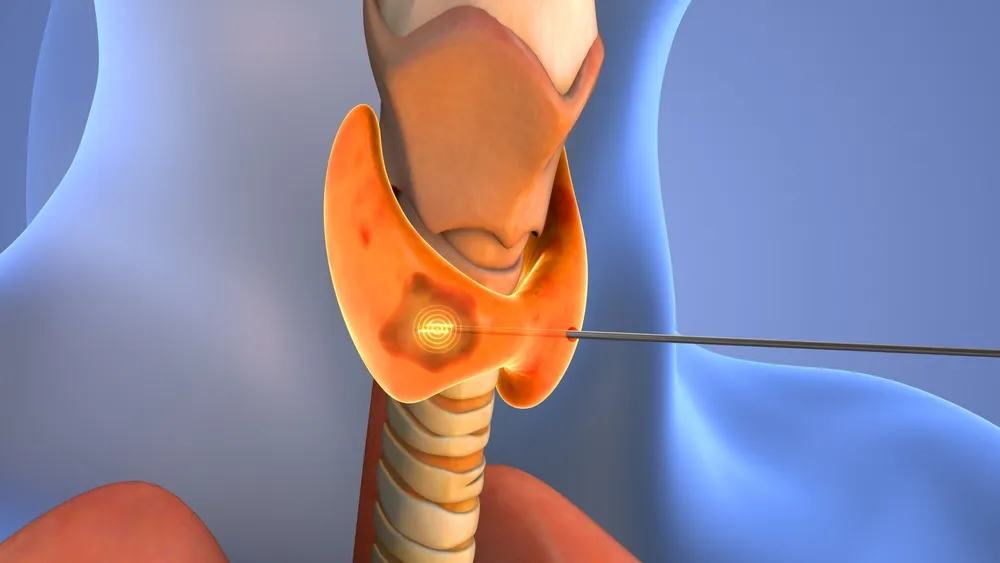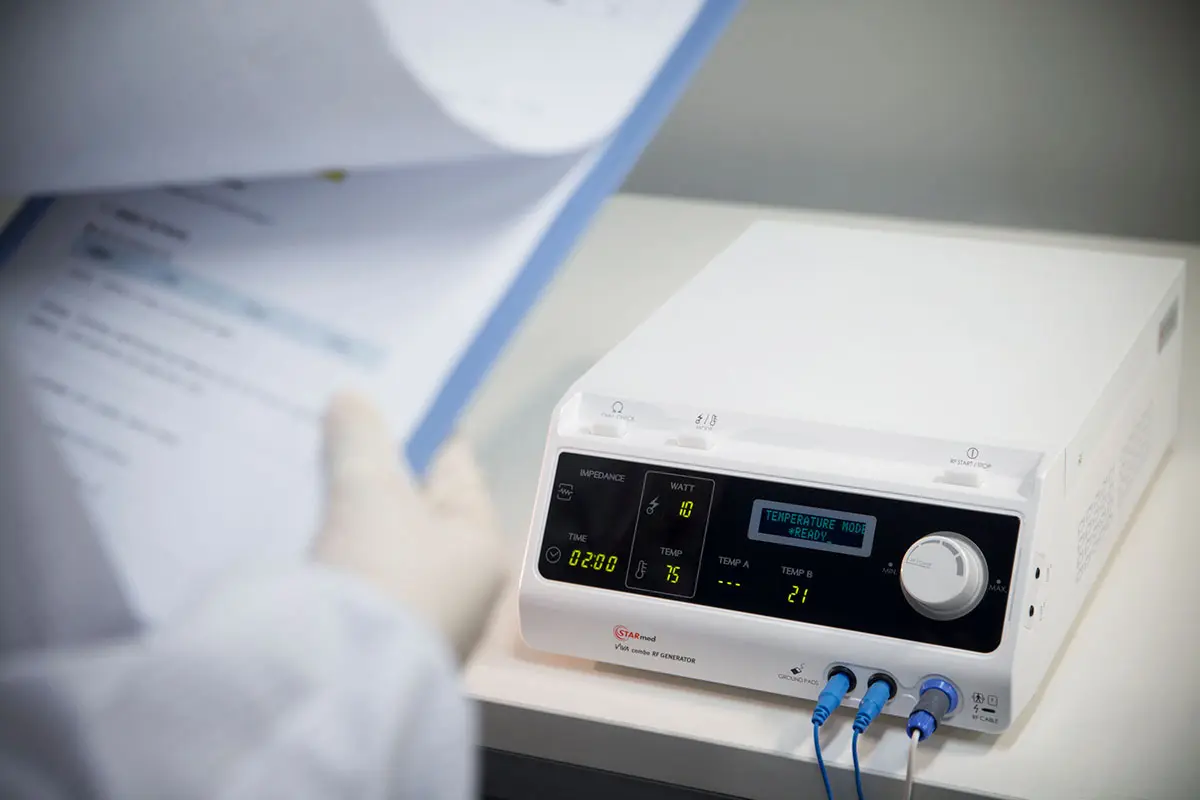Summary:
Radiofrequency ablation (RFA) offers a minimally invasive, cost-effective alternative to thyroid surgery, with quicker recovery and fewer complications. Clinicians should evaluate the need, training, marketing, and reimbursement for RFA integration, considering both financial and non-financial impacts to enhance patient care and practice efficiency.
Main Points:
- Advantages of RFA: Shorter recovery, local anesthesia, outpatient procedure, minimal scarring, low complication rates.
- Considerations for RFA: Assess patient need, clinical evidence, training commitment, marketing plan, reimbursement potential.
- Non-Financial Evaluation: Align with mission, improve outcomes, increase efficiency.
- Financial Evaluation: Conduct financial analysis for ROI, consult financial advisers, consider long-term benefits.
For decades, thyroid surgical procedures were the gold standard in addressing benign nodules. While surgery remains a leading option and is appropriate for many indications, radiofrequency ablation (RFA) is coming into prominence as a minimally invasive, in-office alternative with the power to transform clinical efficiency.
This quick procedure is more cost-effective and less time-consuming than standard thyroid surgery procedures. As a result, clinicians may be able to see and treat more patients without compromising the quality of their care.
As a clinician, how do you determine whether offering this state-of-the-art thyroid ablation procedure is right for your practice? In this blog, we’ll expand on the elements that go into the decision-making process. Ultimately, we hope to help you decide if offering RFA in-office is the appropriate next step for you.
Continue reading to learn how successful STARmed clinicians have integrated RFA into their practice to save time and money while boosting patient satisfaction.
Benefits of Integrating RFA into Clinical Practice
The thyroid RFA procedure has undergone years of research, beginning in 2002. In 2019, STARmed introduced the technology to the American market. Since then, STARmed RFA technology has appeared in over 180 clinical articles. This procedure has been proven to be consistently efficacious by researchers across the world.
Thus, integrating RFA into clinical practice comes with many research-backed benefits for both the physician and the patient.
Benefits of thyroid RFA include:
- Shorter recovery period than surgery, allowing patients to resume activities shorty therafter.
- Can be performed under local anesthesia, improving safety while saving patients and clinicians time and money.
- Performed as an in-office outpatient procedure, with no need for hospitalization in most cases.
- Preserves healthy thyroid tissue, allowing most patients to maintain normal thyroid function.
- Little or no scarring.
- Low complication and infection rate.
- Eliminates the need for lifetime medications in the majority of patients.
- Reduced risk of patients developing primary hypothyroidism.

How to Determine Whether the Thyroid RFA Procedure Is Right for Your Practice
It can be helpful to ask yourself the following questions when determining whether to begin the RFA integration process:
- Is there a need for a less invasive alternative to surgery in your patient community?
- Have you reviewed the most recent clinical evidence to determine if the procedure will be beneficial to your patient population?
- Do you have the time to commit to training with the new technology?
- Do you have a plan to market the new procedure to your patient population?
- Is it possible to receive reimbursement when offering the procedure, increasing your return on investment?
If you choose to integrate RFA into your practice, STARmed offers flexible clinical professional training and support. Additionally, our Star Support program provides marketing and reimbursement support for those with questions about outreach and billing practices.
We’ve outlined additional financial and non-financial considerations below.
Non-Financial Evaluation: Aligning Action with Purpose
Begin the decision-making process by contemplating your mission as a physician. For most, that means questioning whether you’re offering patients the most efficacious, least invasive, and most effective treatment options available. Other clinicians prioritize ongoing professional development out of a desire to remain on the cutting edge of research in their field.
You might ask yourself the following:
- Does thyroid RFA meet a need for your patients?
- Will implementing thyroid RFA help you achieve your practice’s goals and imperatives, including improving patient outcomes?
- Will adopting thyroid RFA enhance the quality of care at your practice and improve the reputation of your clinic?
- Will offering thyroid RFA allow you to increase patient volume and serve more patients more efficiently?
- What are the pros and cons of investing in thyroid RFA technology?
Once you’ve determined if implementing thyroid RFA makes sense for your practice, you can consider conducting a financial analysis.
Financial Evaluation: The ROI of RFA
Often, delivering the most current, effective treatment involves an investment of both money and time. Thus, it is wise to consider whether implementing RFA will yield a satisfactory return on that investment. Investopedia suggests that a financial analysis, or ROI analysis, is the best way to determine if a new technology is profitable enough to warrant a monetary investment.
Furthermore, clinicians can conduct a financial analysis to help determine the incremental cash flow they can expect after adopting RFA technology. The American Academy of Family Physicians recommends consulting with an accountant or other financial adviser before making a major investment decision.
Often, putting in the time to learn new techniques, integrate new technologies, and adjust your office infrastructure can result in a higher level of patient care. In the case of thyroid RFA, you can expect to spend less time on each procedure.
Likewise, versatile, all-in-one equipment allows for effective, efficient, targeted control, yielding positive treatment outcomes. RFA technology frequently targets various conditions in a range of body systems, so you aren’t limited to offering the RFA procedure for the thyroid. Inventory becomes more cost-effective when you choose ablative electrodes with multiple active tip lengths.
The more efficient your practice, the more time you save in the long run, and the more lives you can improve for the better. Those changes have the power to impact your bottom line and your quality of life.
If you have further questions about whether thyroid RFA is right for your clinical practice, our representatives are happy to help. Contact us today to learn more about the RFA thyroid ablation procedure.





